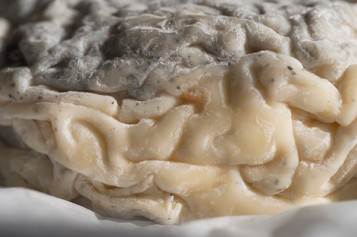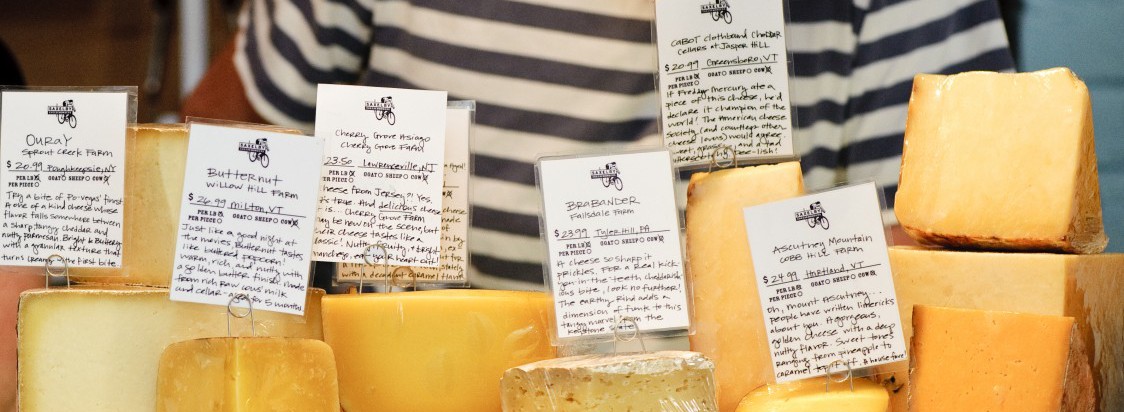 When most of us see a piece of moldy fruit on the countertop, or a piece of cheese gone to seed in the crisper, or glimpse a bit of half-blue bread in the breadbox, we’re instinctively annoyed, let down that our food has gotten away from us and started keeping company with wild, fuzzy, multihued molds. We live in a microbe-phobic world, with expiration dates and best by dates and sell by dates and use by dates slapped upon just about every edible product we come into contact with. The clock is ticking on every bit of food we buy – onwards towards a moldy fate! However, we cheese folk like to take a kindlier view towards the molds and yeasts and all the other little un-seeable forces that have the power to alter our food for the better (through fermentation) or for the worse (just plain old spoiled).
When most of us see a piece of moldy fruit on the countertop, or a piece of cheese gone to seed in the crisper, or glimpse a bit of half-blue bread in the breadbox, we’re instinctively annoyed, let down that our food has gotten away from us and started keeping company with wild, fuzzy, multihued molds. We live in a microbe-phobic world, with expiration dates and best by dates and sell by dates and use by dates slapped upon just about every edible product we come into contact with. The clock is ticking on every bit of food we buy – onwards towards a moldy fate! However, we cheese folk like to take a kindlier view towards the molds and yeasts and all the other little un-seeable forces that have the power to alter our food for the better (through fermentation) or for the worse (just plain old spoiled).
Wintertime is the doldrums for most food production (cheese included) in this part of the world, and it seems apropos to think about time, and its relationship to the food that we eat. The days are short, the produce at the farmer’s markets is scarce, the air outside is cold. The shelves at the supermarket are full; however, that is a relatively recent convenience bestowed upon us by the many scientific and technological and political forces that make up our postmodern food-scape. These are the same forces that gave birth to the bevy of sell by dates, use by dates, and best by dates that now crowd themselves onto every package-able surface of every packaged food product.
The art of fermentation is certainly one of man’s greatest achievements – nutritional, gustatory, and otherwise. Fermentation allows humans to harness the passage of time and, with the help of friendly microbes, use it to their advantage rather than battling against it. Through fermentation the farmer (or chef or home cook) can transform fresh, highly perishable foodstuffs into delicious, living, stable products that can be eaten over the course of the year. It is the stockpiling of sunshine and all the nutrients that go along with it. Fermentation is at its base a manipulation of spoilage. It is intentional, controlled rot, and it has yielded some of the best and most interesting foods in the canon of gastronomy: cheese, pickles, bread, beer, and wine, to name a few.
 Back in the day, winter meals were rife with preserved and fermented foods. Foods in jars and earthenware pots with the most basic of labels – perhaps what was inside and the day that it was made. People ate the preserved bounty of the summer months when there was little else to eat. They put in the time when the harvest was plentiful, and reaped the rewards come winter.
Back in the day, winter meals were rife with preserved and fermented foods. Foods in jars and earthenware pots with the most basic of labels – perhaps what was inside and the day that it was made. People ate the preserved bounty of the summer months when there was little else to eat. They put in the time when the harvest was plentiful, and reaped the rewards come winter.
For our cheesy purposes, we’ll now turn our attention towards milk. Dealing with fresh, fluid milk is perhaps one of agriculture’s greatest battles against time. To begin, the frequency of the cows’ milking is a function of nature and time. Cows (or goats or sheep) on most dairy farms are milked twice daily – once in the early morning and again in the evening – the milking schedule is like bookends to each day. Were the farmers to wait any longer between milkings, the animals would become quite uncomfortable, and would also begin to produce less milk, as their bodies produce only as much as is required of them… i.e. taken out of them, be it by farmer or by calf.
As soon as the milk leaves the udder, the clock is ticking… There are natural microbial forces present within the milk itself and from the environment (the cows’ udders themselves, the air in the barn) working to gobble up the lactose, the sugars present in milk, and sour it. Nowadays with the aid of refrigerated bulk tanks to cool and store milk, farmers can afford to wait a day or two before transforming fresh milk into cheese. The colder temperatures considerably slow the growth of acid-producing bacteria, buying the cheesemaker a bit more time. But in the days before refrigeration, cheesemakers made cheese twice per day – once after the morning milking and again after the evening milking, to keep the pace with the bacteria in the milk.
Finally there is the cheese itself, and its very particular relationship to time. When cheese is being made, the cheesemakers don’t measure in minutes – they monitor and measure when certain changes take place within the milk and the curd. They measure the temperature and acidification of the milk to gauge how well their microbial friends are getting on in their conversion of lactose to lactic acid.
Flocculation is the measure of when the enzymes in rennet (one of the four main ingredients in cheese – milk, culture, rennet, and salt) have begun to rearrange the proteins in the milk to transform it from a liquid into a gel-like curd. The extremely scientific way to see if flocculation is taking place is not by stopwatch, and not even by the changing PH of the milk. The cheesemaker simply spins a flat-bottomed plastic cup on top of a vat of milk and see how long it takes for it to stop spinning. When it doesn’t spin very much at all, coagulation has begun. From that point, it’s a short time until the curd is cut and transformed into a wheel of cheese.
Throughout the making and maturation of cheese, countless thousands of microbes live and die, assisting in flavor development. They are all on their own timetable, dictated not by seconds or minutes, but by the changes taking place within the milk, within the paste of the cheese, and on the rind. When conditions are favorable for them to move in and do their work, they do it. When they have no more work to do, or when the environment of the cheese has changed and there are no more nutrients for them to consume, they die off and release flavor compounds that whether we like to think of it or not, influence the texture and taste of the cheeses we love so much.
As a young wheel of cheese matures, its readiness for eating is cannot be dictated by a predetermined number of days. The affineur (or cheese maturer) measures ripening, and readiness for eating, by touch, by smell, and by taste. The closest we get to a numeric formula for cheese aging is the 60-day aging rule we have here in the United States, an archaic and scientifically wrong measure of how long to age raw milk cheese in order to make it ‘safe’. Aging cheese is like tending a garden. Each variety of cheese has its own arc of maturation, and it is the affineur’s job to notice when the cheese’s needs are changing, care for them accordingly, and then release them for sale when the cheese is at its peak.
In the middle of winter, when the days are short, and in our digital world, when time is at such a premium, it is heartening to think of these things. Some things cannot be timed. You simply have to wait, watch, and taste for them to happen.

